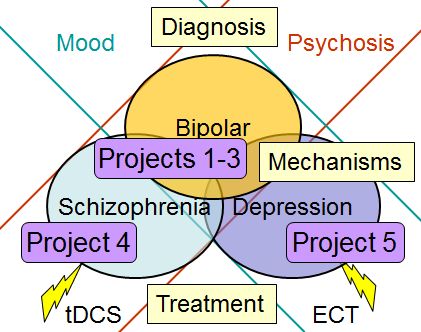
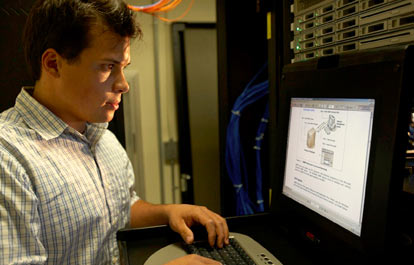
COBRE Phase 2 //
Overview - Multimodal Imaging of Neuropsychiatry Disorders (MIND)
Introduction
Phase II COBRE is a natural extension of phase I COBRE project in Schizophrenia. Multimodal imaging techniques are used in COBRE II to study the neuromechanisms of psychosis and mood disorders. The Phase II COBRE will provide support to five outstanding junior investigators through the assistance of strong senior mentors. The five projects each focus on distinct, but related, aspects of psychosis and mood disorders.
Projects
- Project 1 - Advanced data fusion methods are used to evaluate the ability of multi-modal brain imaging data to differentiate patient groups and to push beyond discrete diagnostic categories by identifying individuals in intermediate positions on the continuum.
- Project 2 - Pilot genetic program is extended from the Phase I to evaluate the shared and unique aspects of genetic influence on brain structural networks using advanced multivariate methods.
- Project 3 - Focusses on the lens of social cognition and evaluate functional networks in patients while perceiving facial and vocal emotions.
- Project 4 - Focusses on auditory hallucinations using MEG and fMRI. Evaluation of the ability to predict hallucinations from the imaging data as well as the impact of transcranial direct current stimulation (tDCS) on the identified brain networks will be investigated.
- Project 5 - Longitudinal design is used to study brain networks related to major depression and relapse after treatment with electro convulsive therapy (ECT).
Cores
Phase II COBRE will have four cores:
- Administrative, Clinical Assessment and Mentoring (ACAM, previously ACAS)
- Multimodal Data Acquisition (MDA, previous IDA)
- Algorithm and Data Analysis (ADA, previously IA)
- Biostatistics and Neuroinformatics (BNI, previously STATNI)
Relationship between Cores and Projects
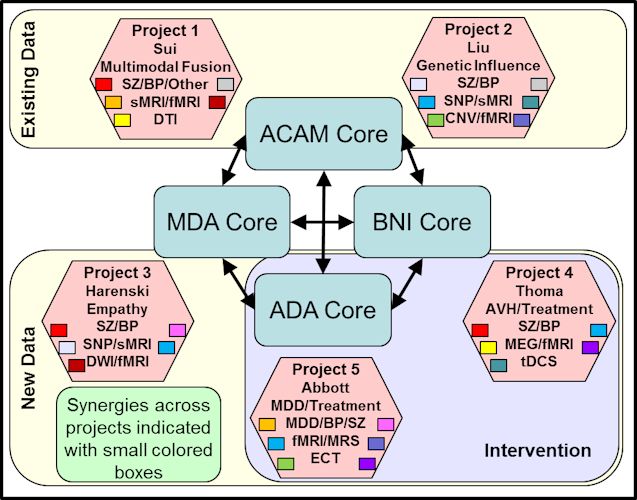
Analytic Relationship between the cores
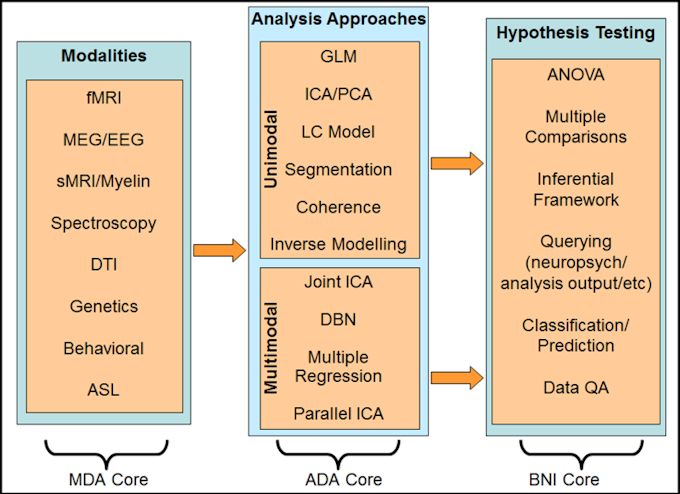
The five projects and four cores will be located at the MIND Research Network (MRN) in Pete and Nancy Domenici Hall. Dr. Vince Calhoun will serve as the principal investigator (PI) of this COBRE. Integration between MRN and UNM is achieved by Dr. Calhoun holding dual roles as an MRN PI and a tenured UNM Professor with appointments in the Electrical and Computer Engineering, Psychiatry, Neurosciences, and Computer Science Departments.
MRN
MRN houses outstanding imaging resources that will be used to support this COBRE: a 306 channel Elekta Neuromag MEG System, a state-of-the-art high density electroencephalography [EEG] lab, an in-house 3T Siemens Trio scanner, and a mobile research 1.5T Siemens scanner. MRN will also provide data processing and management support to the project investigators through a centralized neuroinformatics system, a strong IT management plan, and state-of-the-art image analysis tools. Administrative leadership will be provided by regular meetings between the COBRE PI, the project PIs, the core directors, and the senior mentors. We intend to expand our powerful thematic interdisciplinary center by employing the expertise of senior investigators from Phase I cores. This multidisciplinary team of experts, with MRN’s unique tools at their disposal, will apply their four years of experience from Phase I to examine the neural mechanisms of multiple neuropsychiatric disorders and their treatment using a data-driven approach.
AIMS
The specific aims for this COBRE fall into two broad groups: Scientific and Administrative.
- Scientific:
- To bring together a cadre of investigators with diverse neuroimaging expertise who will work together to combine multiple imaging technologies (e.g., sMRI, fMRI, DTI, MRS, EEG and MEG) to provide an unprecedented understanding of the neuropathology underlying multiple neuropsychiatric disorders.
- To provide these investigators with technological, cognitive neuroscience, and clinical research backgrounds to enhance interdisciplinary and translational research opportunities in New Mexico.
- To apply these scientific resources to the study of our unifying theme (biomarkers in psychosis and mood disorders) in five inter-related projects led by junior investigators who will be mentored by senior scientists.
- Administrative:
- To expand the capability of our facilities and continue to combine the unique resources of MRN with clinical, technological and cognitive expertise in NM to strengthen and grow the diversified neuroimaging research environment and to create a program that will continue to be competitive nationally and internationally.
- To strengthen the mentorship opportunities for junior investigators, post docs and graduate students who work in the New Mexico environment.
- To continue to build a cohesive and collaborative program within which interdisciplinary and translational research can be conducted including a P50-level center grant that will be submitted in year 3 of the Phase II award.
Organizational Chart for COBRE Phase II
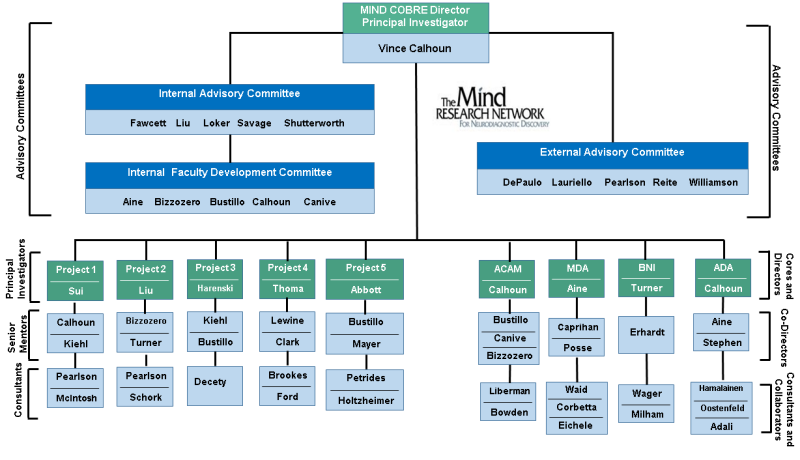
Copyright © 2014 The Mind Research Network.
A 501(c)(3) Non-Profit Organization

